How to Harvest & Preserve Red Raspberry Leaf Tea
This post may contain affiliate links, which means that I may receive a commission if you make a purchase using these links. As an Amazon Associate I earn from qualifying purchases.
Red raspberry leaf is a delicious herb with a taste similar to green tea. See how to harvest, dehydrate, and brew raspberry leaf tea.
Red raspberry leaf tea has been used for centuries as a natural remedy for conditions involving the uterus including pregnancy, childbirth, menstruation, and menopause. See how to harvest and preserve your own raspberry leaf tea.
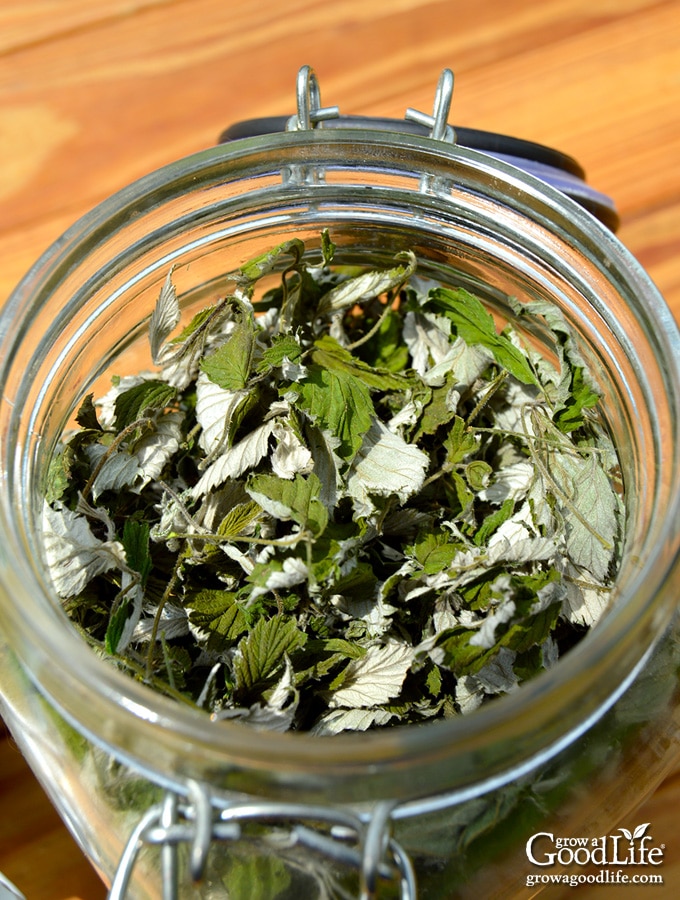
When I planted raspberries (Rubus idaeus) on the property back in 2010 it was for the delicious fruit. It was years later while researching natural remedies to ease my menstrual symptoms that I discovered that red raspberry leaf tea is a natural remedy for conditions involving the uterus, including menstrual support and menopause (Native American Medicinal Plants).
Red raspberry leaves have also been used as medicine for centuries for pregnancy and childbirth, astringent for skin irritations, gargle for sore throats, and for diarrhea. Raspberry leaf tea has no known side effects or drug interactions, but it can lower blood sugar and impede with the absorption of some vitamins (Healing Herbs A to Z).
It is not known precisely why Raspberry Leaf tea is so effective for uterine health. Herbalists believe that the presence of tannins and the alkaloid fragarine combined with other nutrients, including calcium, iron, phosphorus, potassium, and vitamin B, C, and E help tone and relax the pelvic and uterine muscles (Herbal Healing for Women).
After researching, I felt pretty confident in trying red raspberry leaf tea for my menstrual discomforts, and I had plenty of access to leaves to harvest. After drinking red raspberry tea for several months, it relieved a lot of my symptoms, including headache, cramps, and overall energy level and moodiness during that time of the month.
I wasn’t completely convinced until I casually remarked to Kevin that I thought the red raspberry leaf tea was helping. The next thing I knew, he was outside in the raspberry patch harvesting more raspberry leaves for me to use. Hmmm….
How to Harvest, Dry, and Brew Raspberry Leaf Tea
Step 1: Collect raspberry leaves before the plant blooms
Harvest mid-morning after the dew has evaporated and before it the sun is hot to preserve the oils and flavor. Wear gloves and long sleeves to protect yourself from the thorns.
Like most herb, once the plant begins to bloom, the leaves turn bitter. Select young, healthy leaves that have not been treated with chemicals or eaten by bugs, and clip them from the cane.
I grow Heritage raspberries, an everbearing variety that produces two crops each season, a light crop in July followed by a heavy crop in fall. I allow the canes to begin leafing out before pruning the raspberry patch in the spring. I cut whole canes and trim the young leaves off into a large bowl as I prune.
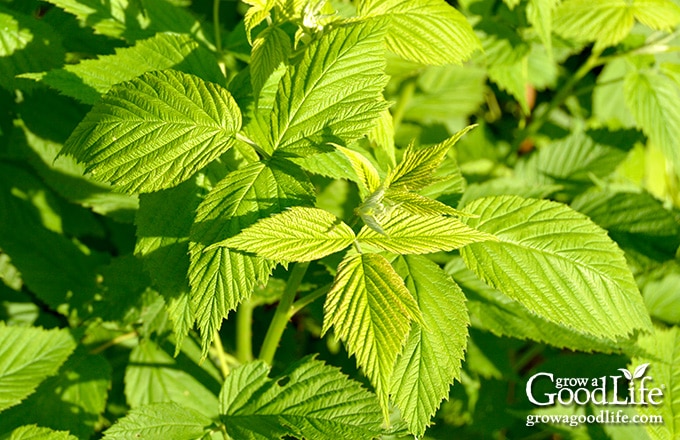
Step 2: Dry the raspberry leaves
You can either let the leaves dry naturally, or use a dehydrator to dry the raspberry leaves quicker. First, wash the leaves well with running water to remove dust and insects and lay them out on a kitchen towel to let some of the moisture evaporate. Then decide how you are going to dry the raspberry leaves:
Let the Raspberry Leaves Dry Naturally: Spread the leaves out on a screen and allow them to dry naturally away from dust and sunlight. Or you can gather the leaves by their stems, tie the ends, and hang them to dry. Depending on the humidity, drying usually takes 1-2 weeks.
Use a Dehydrator to Dry the Raspberry Leaves: The quickest way to dry raspberry leaves is by using a dehydrator. Spread the leaves out on the screens and dry at a low temperature. Check every 30-minutes until completely dry.
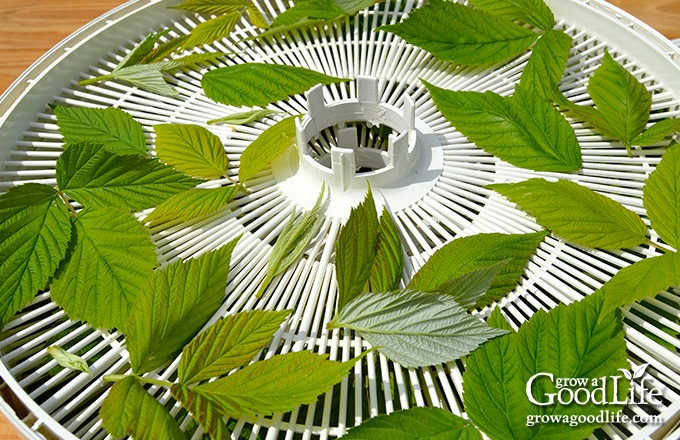
Step 3: Store dehydrated raspberry leaves
You can tell when the leaves are dry, by crushing a leaf or two. It should crumble easily. Once the leaves are dry, store leaves lightly packed in a glass jar away from direct sunlight. Try not to crush them to reserve the flavor until you are ready to brew your tea.
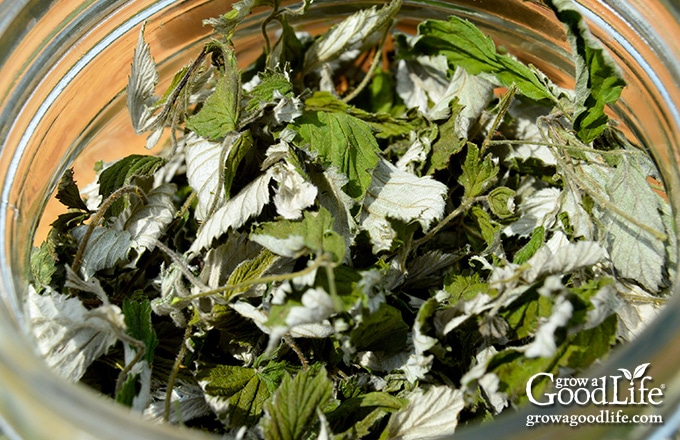
Step 4: Brewing raspberry leaf tea
Red raspberry leaf tea tastes like a mild green tea, but without the caffeine. To make the tea, use about 1-teaspoon of crushed, dried raspberry leaves per 8-ounce cup of boiling water. Steep for at least 5 minutes and drink like regular tea.
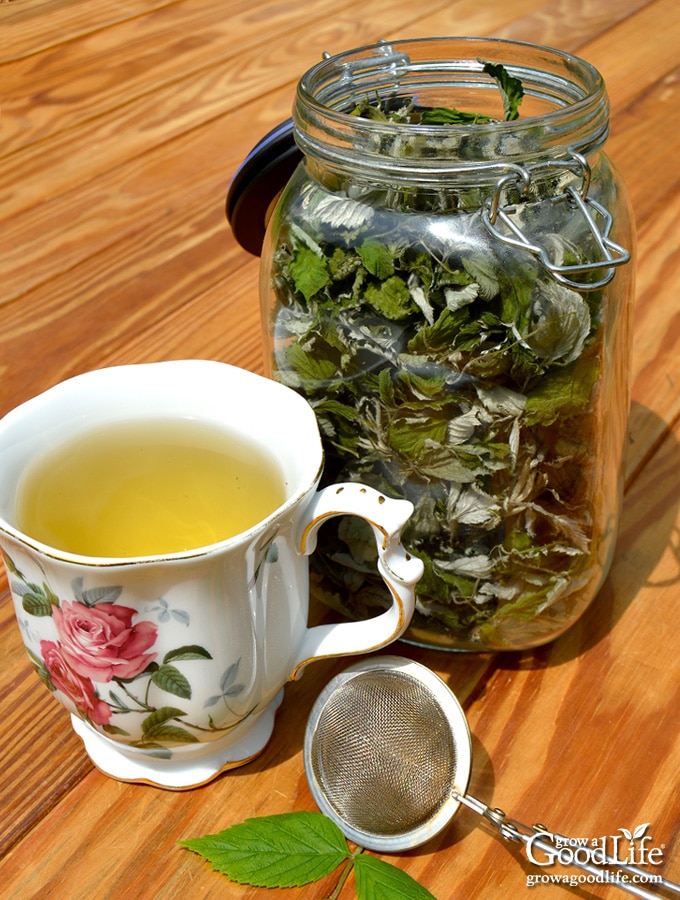
![]()
Want to learn how to use herbs as medicine? Check out the online courses at The Herbal Academy of New England: Introductory Herbal Course and Intermediate Herbal Course.
![]()
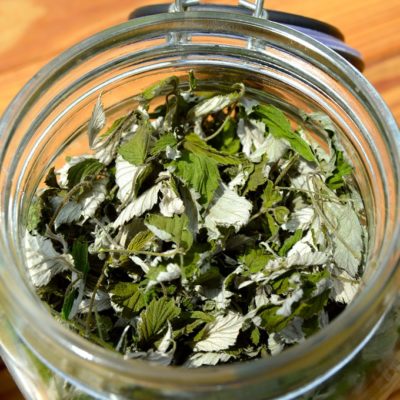
How to Preserve Red Raspberry Leaf Tea
Ingredients
- 1 bunch fresh raspberry leaves
- twine drying screen or food dehydrator
- 1 glass jar for storing
Instructions
- Gather young raspberry leaves.
- Wash the leaves well with running water to remove dust and insects and lay them out on a kitchen towel to let some of the moisture evaporate.
Dry the Raspberry Leaves
- You can either let the leaves dry naturally, or use a food dehydrator to dry the raspberry leaves quicker. First, Then decide how you are going to dry the raspberry leaves:
- Hang and Air Dry: Remove the lower leaves, tie the stems into small bundles, and hang upside down in a dry.
- Drying Screen: Spread the leaves out on a drying screen. Suspend the screen over two chairs so the air can circulate above and below the screen.
- Food Dehydrator: Preheat food dehydrator to 100˚F. Place the herbs in a single layer on dehydrator trays and place in the dehydrator until herbs are dry, 1 to 4 hours depending on the type of herb. Check every 30 minutes to prevent over drying.
- Once the leaves are dry, store lightly packed in a glass jar away from direct sunlight. Try not to crush them to reserve the flavor until you are ready to brew your tea.
- Store the jars in a in a cool, dark place, away from heat, humidity, and temperature fluctuations. Dried herbs will remain potent for 6 to 12 months when stored properly.
- To brew the tea, use about 1-teaspoon of crushed, dried raspberry leaves per 8-ounce cup of boiling water. Steep for at least 5 minutes and drink like regular tea.
Nutrition
Resources and Further Reading:
- Moerman, Daniel E. Native American Medicinal Plants. Portland, OR: Timber Press, 1998.
- Gladstar, Rosemary. Herbal Healing for Women. New York, NY: Touchstone, 1993.
- Stein, Diane. Healing Herbs A to Z: A Handy Reference to Healing Plants. Berkeley, CA: Ten Speed Press, 2009.
- White, Linda B. and Steven Foster. The Herbal Drugstore. Emmaus, PA: Rodale, 2003.
- Purchase Raspberry Leaf Tea from Starwest Botanicals on Amazon.
I am not a doctor and the statements on this website have not been evaluated by the FDA. It is recommended that you consult your medical care provider or herbalist prior taking or relying upon any herbal product.
You May Also Like These Herb Articles:
Good planning is key to a successful vegetable garden
Whether you are new to growing your own food or have been growing a vegetable garden for years, you will benefit from some planning each year. You will find everything you need to organize and plan your vegetable garden in my PDF eBook, Grow a Good Life Guide to Planning Your Vegetable Garden.


Wanneer ga je de gedroogde blaadjes dan malen?
En kun je de gemalen blaadjes ook 6 tot 12 maanden bewaren?
You can grind the dried raspberry leaves just before using them, or after drying if you prefer a finer tea. Either way works! Store the ground leaves in an airtight container in a cool, dark place, and they should keep their flavor and benefits for up to 12 months.
I have black raspberries would it be okay to use them?
Laura, Yes, black raspberry plants can be used to make raspberry leaf tea in the same way as red raspberry plants.
I have often dried whole branches of raspberry leaves in fall – delicious, healthy tea can still be made by adding a few slices of orange in the teapot along with a little honey after brewing 10-15 minutes.
Younger leaves are ideal, but older leaves are fine.
I grew raspberries, and the leaves from those raspberries have died and some new, green leaves have appeared. Are those ok to use?
Linda, Yes, the young leaves are the best to use. So new growth would be perfect.
Doesn’t it kill the plant if u harvest alot if the leaves for the tea
Michelle, Yes, it will kill the plant if you harvest a lot of the leaves, but a few leaves from each plant won’t harm it.
Will the plant still flower and produce fruit if you harvest the leaves?
Keely, Yes, the plant will produce if you don’t harvest all the leaves.
I trimmed my raspberries plants recently because it’s been a rainy season. The ones I trimmed have been growing shoots with young leaves, they will of course not produced this year since it’s Minnesota but I don’t see why I shouldn’t be able to use the new leaves from brand new shoots. (Not a normal thing to happen in September usually it would already by cold.) I’ll try to do some, since I have to wait until growing time again, next year.
When speaking specifically about when to harvest the leaves, you say spring , before the plants have bloomed. My question: it’s summertime, but I do have first year canes that have not produced fruit yet. Are the leaves on my first year canes during the summer just as potent for optimal use?
Heidi, The leaves are most potent before the raspberries plants focus their energy on fruiting. The flavor also turns bitter once the raspberries begin to bloom. Since yours haven’t bloomed yet, you may be ok. You could give it a try and see how it tastes. It should taste like a mild, green tea.
Do you know if you can use golden raspberry leaves instead of red raspberry leaves? Are they interchangeable?
Amanda, The type of raspberries that are historically used for tea are the red raspberry plants with the latin name, Rubus idaeus. I don’t know if the golden raspberries have the same properties.
Hello, have you harvest after all raspberries are gone? unfortunately my raspberries are already bloomed….:'( and what is reason it’s shouldn’t be harvest when it’s bloom?
Thank you!!
ViVi, You can harvest leaves at any point, but the spring leaves are the freshest and healthiest. Once the raspberries begin blooming, the plants energy is directed towards fruit development and this can change the flavor and effectiveness of the leaves when used for tea.